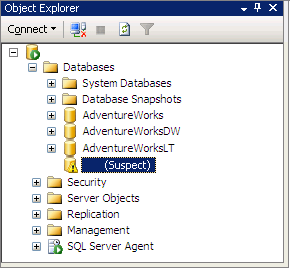SQL Suspect Mode Fix | How to Recover SQL Database from Suspect Mode
What Is SQL Suspect Mode
The Suspect Mode is one of the SQL Server database states, including Online, Restoring, Recovering, Recovery Pending, Emergency, Suspect, and more. A SQL Server database state indicates the current running mode of that database and a Suspect SQL database means that the database recovery process has initiated but not finished successfully, requiring users to fix that issue and repair the corrupted files. Thus, the SQL Suspect Mode further implies that the database is not available for user access: you are unable to connect to the database or recover it during the server startup.

Why SQL Server Marks a Database As Suspect
Your database states may become Suspect for many reasons. Here are some of them:
- Database file corruption
- Unavailable database files
- Improper shutdown of the SQL database server
- Failure to open the device where the data or the log file resides
- SQL server crash
There are more possible causes that may lead a SQL database to be in the Suspect state. But the way to repair an SQL Server Suspect database remains the same. Read on to see how to recover SQL database from Suspect Mode.
How to Recover MS SQL Database from Suspect Mode
SQL Suspect Mode is a common problem encountered by administrators. Based on experience and practice, there is a proven way to recover MS SQL from Suspect Mode:
Step 1: Switch the database to the Emergency Mode.
Start the Microsoft SQL Server Management Studio and connect your database
Choose "New Query"
Turn off the suspect flag on the database and switch it to EMERGENCY
EXEC sp_resetstatus 'db_name';
ALTER DATABASE db_name SET EMERGENCY
Step 2: Perform the function Consistency Check on the Master Database.
DBCC CHECKDB ('database_name')
Step 3: Bring the database into Single User Mode, and then roll back the previous transactions.
ALTER DATABASE database_name SET SINGLE_USER WITH ROLLBACK IMMEDIATE
Step 4: Back up the database since the next operation may cause data loss.
Step 5: Execute Database Repair allowing some data loss.
DBCC CHECKDB ('database_name', REPAIR_ALLOW_DATA_LOSS)
If you lost some database files after this operation and do not have any backup available, you can get your files back with the professional hard drive recovery software.
Step 6: Change the database into Multi-User Mode.
ALTER DATABASE database_name SET MULTI_USER
Step 7: Refresh the SQL database server and check the connectivity of the database.
In most of the cases, users will repair the Suspect database and reaccess it following the steps above. However, it happens that the solution can't recover the SQL database from Suspect Mode to Normal, which always occurs when the SQL server device files are badly corrupt. If you are in such a situation, don't hesitate to try Qiling MS SQL recovery tool to repair your database and recover lost records.
Feature Highlights:
- Repairs corrupted SQL database files (MDF/NDF files)
- Repairs corrupted SQL server database components - tables, triggers, indexes, keys, rules & stored procedures
- Recovers deleted/dropped records from SQL Database
- Allows to save the database scan results to resume data recovery at a later stage
It will help you repair your database when you cannot recover your MS SQL from the Suspect Mode and enable you to solve common SQL database errors.
Follow the steps to perform a database repair:
Step 1. Select file types and click "Next" to start.
- Launch Qiling MS SQL Recovery.
- Select the corrupted database file by clicking "Browse" (the two dots) or "Search".
- Run Qiling SQL Recovery, select file types and click "Next" to start.

Step 2. Select the corrupted database for recovery
- After selecting the file, click the "Scan" button to start the Analyzing process.

Note: To use this software, you need to stop the SQL Server service.
Step 3: Repair the corrupted database
- The software displays all the recoverable items in a tree-like structure. The items are shown in a left pane.
- Select the desired component to be recovered. From the window, click the "Export" button.

Step 4: Export to the database or as scripts
- Choose to export the database objects to database or export the items as scripts
- If you choose "Export to database", enter the information required and choose the target database.
- A window appears up asking you to provide credentials to connect to the server and the destination to save the recovered items. In order to begin the repairing process, click "OK".
Note: Before clicking "OK", you need to restart the SQL Server service.
Related Articles
- How to Export Data from SQL Server to Excel Automatically
- [Fixed] SQL Error 945 | Database Cannot Be Opened due to Inaccessible Files
- How to Recover Deleted SQL Server Database without Backup
- How to Fix A Corrupted SQL Server Transaction Log File